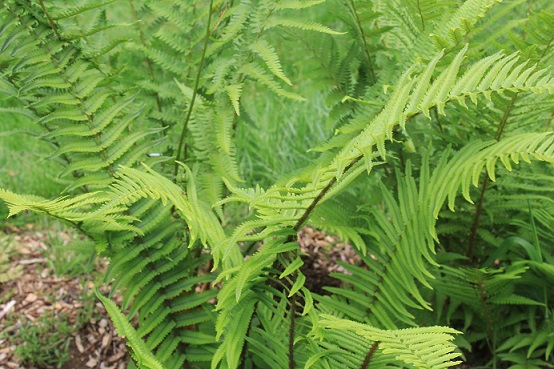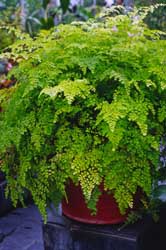Present since Prehistoric times with over 10,000 species!
This course will teach students about:
- Propagation (spores, division, tissue culture),
- Different groupings (e.g., epiphytes, ground ferns, tree ferns) of both common and uncommon species.
- Various growing techniques (baskets, indoor/outdoor containers, terrariums), and
- A range of cultural methods (soils, watering, pest & disease control) for various fern species.
Whether professionally or personally motivated, this comprehensive course on 'all things fern' will open your eyes to the diversity and beauty of this variety.

COURSE CONTENT
Emphasis is placed on the horticulturally valuable species. Each lesson is outlined below:
1. Introduction
- Review of the system of plant identification,
- General characteristics of the ferns (especially the fronds),
- Main groups of ferns (filmy, tree, terrestrial, epiphytic and water ferns),
- Information contacts (i.e., nurseries, seed, clubs, etc.),
- Pronunciation of plant names.
2. Culture
- How best to grow ferns and what conditions they need.
- Planting, mulching and watering,
- Pests, diseases and their control,
- Feeding and pruning,
- Protection from wind, salt air, etc.,
- Compost making.
3. Propagation
- Methods of propagating ferns - spores, division, tissue culture, and
- Propagation of selected varieties.
4. The Most Commonly Grown Varieties
- Maidenhairs, tree ferns, stags, elks, common ground ferns, and
- How to grow and propagate these ferns.
5. Other Important Groups
- Asplenium, Blechnum, Nephrolepis, Pteris and other groups.
- Group characteristics, cultural details, propagation methods.
6. Other Varieties
- Hares foot fern, Bracken, Fans, Corals and Combs.
7. Making the Best Use of these Plants
- In containers, hanging baskets and terrariums,
- In the ground, as indoor plants, growing and showing, and
- Growing for profit (to sell the plants or what they produce).
8. Special Assignment - Detailed culture and identification of one genus.
COURSE AIMS
- Distinguish between different types of ferns in cultivation, including twenty different genera and fifty different varieties.
- Determine critical cultural practices required to successfully grow ferns in different specified situations.
- Determine the cultural requirements of specific fern varieties.
- Apply various specialised techniques to the culture of ferns.
- Prepare a planting plan for an area using ferns.
Note that this is an experiential learning-based course. Throughout your studies you will have the opportunity to network with and learn from a variety of industry professionals. Establishing real-world relationships and confidence is key to career success. Several tasks throughout the course will provide you with the opportunity to start creating a comprehensive network of connections.
Each lesson culminates in an assignment which is marked by an expert tutor and returned to you with feedback including suggestion of additional resources, specialised information, and more. The special assignment which comprises the last lesson will give you an opportunity to apply the knowledge and skills you have acquired throughout the course.
How Can You Propagate Ferns? 
Propagating ferns can be one of the most enjoyable and addictive activities you may ever embark upon. Ferns can be propagated either by spores or by vegetative techniques, depending on the variety.
Generally, spore propagation is the simplest method and the most economical way of producing a large number of new plants quickly. A few varieties will only propagate by vegetative means. In other instances, vegetative propagation is preferred to spore propagation for one of a number of reasons.
Spores are generally produced as a result of two plants cross-breeding with each other, although many plants may self-fertilise. Plants grown as a result of cross-breeding may display a mixture of characteristics from the two parents. That is, they do not necessarily turn out like the plant which the spore originally came from, or in the case of self- fertilisation, different combinations of chromosomes from the same parent produce different characteristics in the offspring; although differences are generally not as great as those produced by cross-breeding.
Almost all ferns can be propagated form spores found on the underside of the fertile fronds. Spores are produced in large quantities and look like a brown dust to the naked eye.
With vegetative propagation, a piece of existing plant is treated in some way to cause the development of roots and top growth, thus producing a new plant. As there is only one parent, the new plants will have all of the same characteristics of the parent plant.
There are other ferns which can be propagated vegetatively by division, from bulbils, tissue culture, layering or cuttings. It is important to apply the appropriate method to each fern and situation to obtain a successful outcome.
Dive into the wonderful world of ferns! Gain theoretical and practical knowledge which will last you a life time!
Why Study with ACS?
Design your own learning pathway.
Study at your own pace, from anywhere, at any time.
Receive prompt, expert support from our team of committed and friendly tutors.
Your learning is our priority. We are flexible and adaptable to meet your educational needs!
WHAT NEXT?
Register to Study - Go to “It’s Easy to Enrol” box at the top of the page and you can enrol now.
or
Get Advice – Email us at info@acsedu.co.uk OR
Use our FREE COUNSELLING SERVICE to contact a tutor
CLICK TO CONTACT US